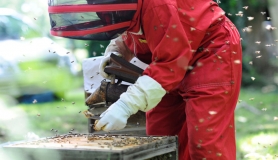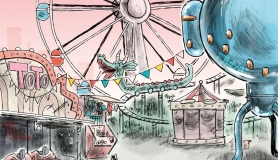If you are the mother of a teenage girl, you are likely to be receiving a pretty strong message from friends, family and even experts, to “let her go”. It is necessary that she find her independence on her own or with her peer group, you’ll be told, and you’ll likely be accused of hovering if you stay close. This new conventional wisdom has led me to wonder: how has it come to be that we value our child’s urge for independence more than their instinct for closeness? The older, perhaps foundational truth that a child’s and then a teenager’s natural dependence on her parents can create a true and lasting independence, seems to have been lost along the way.
As a psychotherapist, I have been interested in these questions for a long time, but when I became a mother of an adolescent daughter, finding their answers became more urgent. My now 22 year old daughter Eliza and I have taught mother/daughter workshops for six years and we have recently co-authored Mothering & Daughtering: Keeping Your Bond Strong Through the Teen Years, a book which challenges this current conventional wisdom that mothers need to let their teenage daughters go to let them grow.
DAILY PRACTICE
If truth be told, I have been mothering since I was a child. I doted on my dolls into my adolescence, and early on embraced the mother archetype as both a personal and professional identity for life. I am grateful that my professors in graduate school encouraged the development of my intuition and empathy as crucial companions to my clinical knowledge. And after years of teaching, including co-teaching Mothering & Daughtering workshops with Eliza, I have come to define effective mothering simply as “raising your daughter (or son) to become herself (or himself).’ For me this means that I have made mothering the daily practice of living my own life, so that Eliza is free to live hers. C.G. Jung once said, “The greatest burden a child must bear is the unlived life of the parent,” and I have worked hard at separating out my version of who I think Eliza should be, from who in fact she is—and is becoming.
This towering observation by Jung actually has lots of down to earth implications for mothers who fear or already struggle with a clash of wills with their teenage daughters and are confused about whether they should be holding on or letting go of them. I principally try and guide mothers to a deeper capacity within themselves that already knows how to raise a daughter to become her truest self and to stay right by her during the tumultuous teen years. This capacity is intuition, a right-brain skill our left-brain culture does not encourage us to develop. I have developed my own intuitive, emotional intelligence and consciousness as I raised my daughter and I have guided mothers in developing theirs.
GROWING CONFIDENCE
Please note however that conscious mothering is not perfect mothering. It is a daily practice that does not consider perfection a desirable or obtainable goal. My own consciousness and confidence grew as I mothered my teenage daughter very imperfectly. Through the process, I landed on the four cornerstones of the Mothering & Daughtering approach (see right).
These cornerstones challenge the conventional wisdom that teenagers need to reject their mother (and father) to grow up and that we parents are supposed to let them figure out the answers to life’s lessons on their own. Many believe that a rupture in the relationship is inevitable. Through our own relationship, and now our work together, Eliza and I have learned that mothers and daughters can come through this critical passage from child to adult with a strong bond and as friends. We humans are wired for attachment and connection, and an adolescent’s attachment to her parents is necessary so that she might take her cues from adults, not from her peers.
INTIMACY AND AUTHENTICITY
Our daughters (and sons) are being wooed more and more actively—and at an earlier age than ever before—by what Canadian psychologist Gordon Neufeld has called attachment competition. More than likely, it has not escaped your attention that there is a powerful undercurrent pulling your daughter away from you and toward her peers. You have probably heard from others—be they friends, family or experts—that this pull to her teen peer group as the new central structure in her life (her new family) is a normal and necessary step as she exerts her independence. But I am recommending that you rethink this notion. A peer group is not a parent, and its unreliable herd thinking makes the intimacy and authenticity your daughter needs at this time hard to find. I have observed that some of our daughters are determined to bring themselves up on their own, or are looking to their peers for the emotional support and guidance they need through adolescence. Yet, an adolescent peer is simply not developmentally capable of providing the steady and mature counsel that our daughters need from adults, and it will cause our daughters tremendous anxiety if their peer group is their primary source of counsel and support.
BEING MORE PRESENT
Your adolescent daughter is becoming an individual—both separate from and connected to you. Psychological and neurobiological research has demonstrated that she needs you to be more present, not less, as she seeks a new identity. Let’s be clear: A thriving relationship includes tension and disagreements, both of which are grist for the mill. However, this “grist” does not have to be destructive to the relationship. Instead, you can and should use the tension and disagreements to help the relationship grow, rather than erode. Even if she seems to be saying otherwise, your adolescent daughter needs and wants to be close and connected to you as she establishes an authenticity that will give her the confidence she needs in life.
We mothers need to learn to read and trust our daughters’ instinct to stay close. Resistance to you and your guidance doesn’t mean she wants you gone. On the contrary, she needs you to acknowledge and appreciate her independent thinking. It is developmentally appropriate for her to resist you and your guidance; she is finding her own thoughts and feelings, which need to be separate from yours. Imagine how satisfying your relationship with your daughter could be if every time she appeared to be resisting you, you reframed her resistance for what it really is: a search for her true self. Her instinct is to be independent and to remain connected to you at the same time. You must encourage her in both endeavours.
But you will be challenged—and not just by your daughter. I know that my parents watched with some concern as they watched my hands-on approach to mothering. Their parenting style with me and my brothers in the 1970s, for better or worse, was very laissez-faire. Whenever we get looks or feedback - even jokes about our hands-on parenting style (some call it attachment parenting), we need to consult our own experience and intuition for guidance: Wouldn’t we, as teens, have loved such a reliable and connected relationship with our mothers?
OPPORTUNITY TO CONNECT
If we understand that there is a positive reason for why she is pushing us away or being moody or picking a fight, we will be able to transform a potentially negative interaction with our daughter into an opportunity to connect. Consider this kind of interaction as a kind of martial arts encounter—I don’t mean a kung-fu street battle, but rather a daily practice session of an ancient and honed dance, one where we meet changing energies with solid purpose. Since you are the adult in this martial arts dance, it is likely that you have earned quite a few more belts than your daughter-partner has. You may not have earned these belts in the family in which you grew up, but think about the belts you have earned in other intimate relationships. If you remain conscious of the fact that deep down she always, always wants to connect, then you will recognize your daughter’s moody cues as a signal of her need, not as a rejection of you. You will know in the moment how to make the most effective and strategic mothering-as-a-martial-art move. And as these conscious moments turn into days, weeks, months and years, before you know it you will find yourself sitting across from a self-assured and loving young woman, who is also your daughter.
The Four Cornerstones
1. You and your daughter have a bond for life. It is together, as a team, that you can make this bond positive and enduring. If you are committed to staying connected through your daughter’s teen years, you are more than halfway there.
2. You, her father or your partner are the most important people in your daughter’s life. Her relationship with her father is for another discussion, but here is what is true about her relationship with you: she longs to rely on you, to share her private matters with you, to learn how to love her feminine body and self, and to have her new and emerging identity as a woman lovingly mirrored back to her.
3. Your adolescent daughter actually wants and needs you to stay at the centre of her life. It is important that you are conscious of this, even if she isn’t. It is by you staying reliably at the centre of her life, as a steady and mature presence, that she can find her way to healthy independence as a true adult.
4. When the mother-daughter bond is strong, the challenges of raising an adolescent daughter tend to invigorate, rather than exhaust, a mother. A strong mother-daughter bond is the foundation from which good communication happens, trust grows, and limits are honoured. Did I mention that it is also much more fun?
Sil Reynolds has been leading Mothering & Daughtering weekend workshops, with her daughter Eliza, in the US, since 2006. Find out about her work at motheringanddaughtering.com.
Books worth reading:
Mothering and Daughtering by Sil and Eliza Reynolds
The Myth of Maturity: What Teenagers Need from Parents to Become Adults by Terri Apter
Hold On To Your Kids: Why Parents Need to Matter More Than Peers Gordon Neufeld & Gabor Mate
Mother-Daughter Wisdom: Understanding the Crucial Link Between Mothers, Daughters, and Health by Christiane Northrup







